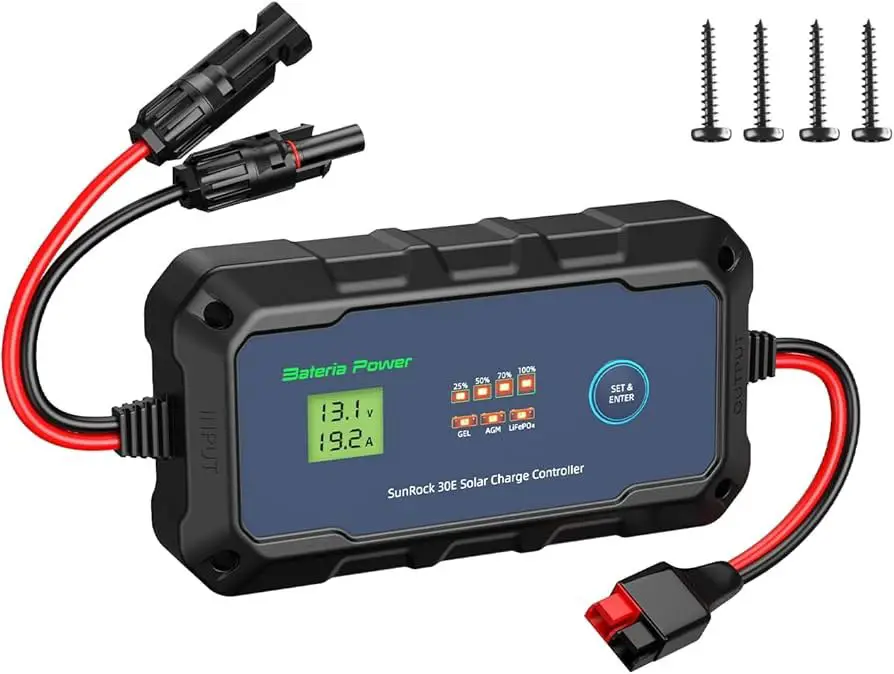Yes, your camper battery charges when plugged into a 30-amp outlet. The converter charges the battery while supplying power.
Many RV enthusiasts often wonder if their camper battery charges when plugged into a 30-amp outlet. Understanding this is crucial for maintaining a reliable power supply during trips. Plugging your camper into a 30-amp power source not only powers your appliances but also charges your camper’s battery.
This ensures that your battery remains charged, providing a backup power source when shore power is unavailable. Keeping your battery charged extends its life and ensures all systems operate efficiently. Proper battery maintenance is essential for a trouble-free camping experience, ensuring you have power whenever you need it.
Introduction To Camper Battery Charging
Understanding how to charge your camper battery is crucial. It ensures your adventures are smooth and uninterrupted. This guide will help you navigate the basics of camper battery charging. We’ll cover why charging is important, and common methods used.
Why Battery Charging Is Crucial
Battery charging is essential for a camper’s electrical system. Your camper needs power for lights, appliances, and devices. Without a charged battery, many conveniences stop working. A well-charged battery ensures safety and comfort during your trips.
Regular charging extends the life of your battery. Batteries lose charge even when not in use. Keeping them charged prevents deep discharges, which can damage the battery. It also helps in maintaining the battery’s overall health.
Common Charging Methods
There are several ways to charge a camper battery. Each method has its own benefits. Here’s a look at the most common ones:
- Shore Power (30 Amp): Plugging into a 30 Amp source is a popular method. It allows you to use campground power to charge your battery.
- Solar Panels: Solar panels offer a renewable energy source. They are ideal for long trips off the grid.
- Generator: A generator provides a reliable power source. It’s useful in remote areas without shore power or sunlight.
- Alternator: When you drive, your vehicle’s alternator can charge the camper battery. This method is automatic and convenient.
Choosing the right method depends on your needs and trip plans. Shore power is best for campgrounds. Solar panels and generators suit remote locations. The alternator is handy while driving.

Credit: www.amazon.com
Understanding 30amp Service
Many RV owners often wonder, does their camper battery charge when plugged into a 30Amp service? To answer this, you need to understand what 30Amp service is. Let’s dive into the details and explore the differences between 30Amp and other services.
What Is 30amp Service?
30Amp service is a common power supply for RVs. It delivers a single 120-volt power source. This service can handle up to 3,600 watts of electrical load. This amount is generally enough for most campers. It allows you to run various appliances and charge your battery.
Differences Between 30amp And Other Services
There are several power options available for RVs. The most common are 30Amp and 50Amp services. Understanding their differences is crucial.
| Service Type | Voltage | Wattage | Appliance Capability |
|---|---|---|---|
| 30Amp Service | 120 Volts | 3,600 Watts | Basic appliances and battery charging |
| 50Amp Service | 120/240 Volts | 12,000 Watts | Heavy-duty appliances and multiple devices |
50Amp service provides more power compared to 30Amp. It allows you to run multiple heavy-duty appliances simultaneously. This service is ideal for larger RVs with more electrical needs.
With 30Amp service, you need to be mindful of your power usage. Running too many devices at once can trip the breaker. But it is sufficient for most basic needs and charging your camper battery.
How 30amp Service Affects Battery Charging
Understanding how a 30Amp service affects your camper battery is crucial. It ensures your camper stays powered during your adventures. Let’s explore the details.
Direct Charging Mechanism
When you plug your camper into a 30Amp service, the battery starts charging. The power flows directly from the service to the battery. This ensures a steady flow of electricity. The power converter in your camper plays a key role. It converts the AC power from the 30Amp service to DC power. This DC power is what charges your camper battery.
Impact On Charging Speed
The 30Amp service provides more power compared to lower amp services. This means your battery charges faster. The charging speed depends on the battery’s capacity and the power converter’s efficiency. A high-quality power converter charges your battery more quickly. The state of your battery also affects the charging speed. A fully depleted battery takes longer to charge. Regular maintenance of your battery ensures optimal charging speed.
| Service Type | Charging Speed |
|---|---|
| 30Amp Service | Faster |
| 15Amp Service | Slower |
Using a 30Amp service for your camper battery is beneficial. It ensures your battery charges efficiently and quickly. This keeps your camper powered for longer periods.
Necessary Equipment For Charging
When you’re plugged into a 30Amp power source, having the right equipment is crucial for charging your camper battery efficiently. Below are the necessary components you need to ensure your battery stays charged.
Inverters And Converters
An inverter converts DC power from your battery into AC power. This allows you to use household appliances in your camper. On the other hand, a converter changes AC power from the 30Amp source into DC power to charge your battery. Both are essential for maintaining a steady power supply.
| Equipment | Function |
|---|---|
| Inverter | Converts DC to AC |
| Converter | Converts AC to DC |
Essential Cables And Connectors
To ensure a smooth power transfer, you’ll need the right cables and connectors. These include:
- Heavy-duty extension cords for 30Amp power
- Battery cables with proper gauges
- Plug adapters for different socket types
These components are essential for a secure and efficient power connection. Make sure your cables are in good condition to avoid power loss or damage.
Safety Considerations
When plugging in your camper to a 30Amp outlet, safety is crucial. This ensures your battery charges efficiently and safely. Ignoring safety can lead to overcharging or electrical hazards.
Avoiding Overcharging
Overcharging can damage your camper battery. It can reduce the battery’s lifespan. Use a charge controller to monitor the charging process. A charge controller will stop charging once the battery is full. This prevents overcharging and extends battery life.
| Device | Function |
|---|---|
| Charge Controller | Stops charging when battery is full |
Preventing Electrical Hazards
Electrical hazards can occur if connections are not secure. Loose connections can cause sparks or fires. Always check the connections before plugging in.
- Inspect the plug for damage.
- Ensure the outlet is in good condition.
- Use a surge protector to safeguard against power surges.
By following these steps, you can prevent electrical hazards. Safety should always be your top priority.

Credit: www.reddit.com
Troubleshooting Charging Issues
If your camper battery is not charging while plugged into a 30Amp outlet, you may need to troubleshoot. This section will help identify common issues and solutions. Understanding potential problems can save you time and frustration.
Common Problems And Solutions
Here are some frequent problems and their solutions:
- Faulty Converter: The converter might not be working. Check the fuses and connections.
- Blown Fuse: A blown fuse can stop the charging process. Replace any blown fuses immediately.
- Poor Connections: Loose or corroded connections can hinder charging. Clean and tighten all connections.
- Old Battery: Older batteries may not hold a charge. Test the battery’s health and replace if needed.
When To Seek Professional Help
If these solutions don’t work, consider professional help:
- Complex Electrical Issues: If the problem persists, it might be a complex issue.
- Safety Concerns: Electrical troubleshooting can be dangerous. If unsure, seek help.
- Warranty Considerations: Tampering with electrical systems can void warranties. Consult professionals to avoid this.
| Issue | Solution |
|---|---|
| Faulty Converter | Check fuses and connections |
| Blown Fuse | Replace blown fuses |
| Poor Connections | Clean and tighten connections |
| Old Battery | Test and replace battery |
Maximizing Charging Efficiency
Understanding how to maximize charging efficiency is vital for your camper. When plugged into a 30Amp source, knowing the best practices ensures your battery stays healthy and charges quickly. Below, we explore key aspects to help you achieve this.
Optimal Charging Times
Charging your camper battery during the day is ideal. Daytime charging allows solar panels to assist if available. If plugged into a 30Amp source, aim for charging in the morning. This ensures your battery is ready for the evening. Consistent charging times help maintain battery efficiency.
Maintaining Battery Health
Maintaining battery health is crucial for longevity. Avoid overcharging by monitoring the charge levels. Using a smart charger can help regulate the process. Keep an eye on battery temperature; extreme heat can damage it. Regularly clean the battery terminals to prevent corrosion. These practices ensure a longer battery life.

Credit: www.reddit.com
Real-world Tips And Best Practices
Charging your camper battery while plugged into a 30Amp source is crucial. Following real-world tips and best practices ensures your battery stays healthy and reliable. This section dives into valuable insights from both users and experts.
User Experiences
Many users have shared their experiences with charging camper batteries on forums. Here are some common tips:
- Regularly check the battery voltage to avoid overcharging.
- Use a quality charger that matches your battery type.
- Ensure all connections are clean and secure.
- Monitor the battery temperature during charging.
Expert Recommendations
Experts suggest the following best practices for optimal battery charging:
- Install a smart charger to maintain battery health.
- Keep the battery area well-ventilated to prevent overheating.
- Use a multimeter to regularly check voltage levels.
- Follow the manufacturer’s guidelines for charging cycles.
Table Of Common Issues And Solutions
| Issue | Solution |
|---|---|
| Battery not charging | Check connections and charger compatibility. |
| Overheating | Ensure proper ventilation and use a fan. |
| Voltage drop | Inspect for loose or corroded connections. |
By following these tips and recommendations, you can ensure your camper battery charges efficiently and safely.
Frequently Asked Questions
Does My Camper Battery Charge When Plugged Into 30amp?
Yes, your camper battery charges when plugged into a 30Amp outlet. The converter in your RV converts AC power to DC, charging the battery.
How Long Does It Take To Charge A Camper Battery On 30amp?
Charging time depends on the battery’s capacity and current charge level. Typically, it takes around 6-8 hours for a full charge.
Is It Safe To Leave My Camper Plugged In?
Yes, it is generally safe to leave your camper plugged in. Modern RVs have smart charging systems to prevent overcharging.
What Happens If My Camper Battery Is Not Charging?
If your camper battery isn’t charging, check the converter, connections, and fuses. Consult a professional if the issue persists.
Conclusion
Charging your camper battery on a 30Amp plug is possible and efficient. Ensure your converter or charger is functioning correctly. Regular maintenance and monitoring are key. By keeping your battery charged, you’ll enjoy uninterrupted adventures. Safe travels and happy camping!


